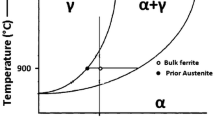Abstract
The effects of phosphorus, tin, and silicon on the magnitude of Lüders strain in low-carbon sheet steels have been studied. At equivalent grain sizes the Lüders strain was effectively reduced by the P or Sn additions. However, when various amounts of Sn were added to a steel containing 0.07 pct P, incremental effects of increasing Sn content could not be recognized; the combined effect of Sn and P on Lüders strain was nearly the same as the effect produced by a slightly higher P alone. Additions of Si to a 0.05 pct P-treated steel, even up to fairly high concentrations, produced very little effect on the Lüders strain. The magnitude of Lüders strain, as influenced by the grain size, is a linear function of d-1/2, this relation being similar in form to the Hall-Petch relation for yield or flow stress and grain size. The effect of P or Sn on this relation is to decrease the slope of the straight-line plot. These observations have been analyzed on the basis of Lüders strain in relation to the band-front velocity and the contribution of the mobile dislocation density and velocity product (ρv) to the strain rate. Solutes that effectively increase the density of mobile dislocations generated from the grain-boundary sources should decrease the magnitude of Lüders strain.
Similar content being viewed by others
References
S.R. Goodman: U.S. Steel Research Laboratory, Monroeville, PA, unpublished research, 1980.
D. C. Ludwigson: U. S. Steel Research Laboratory, Monroeville, PA, unpublished research, 1972.
K. Matsudo: Technical Research Center, Nippon Kokan K. K., Fukuyama, Japan, private communication, 1981.
E. O. Hall:Yield Point Phenomena in Metals and Alloys, Plenum Press, New York, NY, 1970, pp. 1–126.
Reference 4, pp. 30–31.
A. H. Cottrell: inThe Relation Between the Structure and Mechanical Properties of Metals, Proc. National Physical Laboratory Symposium No. 15, Teddington, Middlesex, published by Her Majesty’s Stationery Office, 1963, vol. II, pp. 456–73.
H. Hu: U. S. Steel Research Laboratory, Monroeville, PA, unpublished research, 1975.
H. Hu: inFormable HSLA and Dual Phase Steels, A. T. Davenport, ed., Conf. Proc. published byTMS-AIME, New York, NY, 1979, pp. 109–25.
E.W. Hart:Acta Met., 1955, vol. 3, pp. 146–96.
D.W. Moon and T. Vreeland, Jr.:Scripta Met., 1968, vol. 2, pp. 35–40.
W. Sylwestrowicz and E.O. Hall:Proc. Phys. Soc., 1951, vol. B64, pp. 495–502.
D.F. Stein and J.R. Low, Jr.:J. Appl. Phys., 1960, vol. 31, pp. 362–69.
R.W. Guard:Acta Met., 1961, vol. 9, pp. 163–65.
J.C.M. Li:Trans. TMS-AIME, 1963, vol. 227, pp. 239–47.
E. Hornbogen:Trans. ASM, 1963, vol. 56, pp. 16–24.
Author information
Authors and Affiliations
Rights and permissions
About this article
Cite this article
Hu, H. Effect of solutes on lüders strain in low-carbon sheet steels. Metall Trans A 14, 85–91 (1983). https://doi.org/10.1007/BF02643741
Received:
Issue Date:
DOI: https://doi.org/10.1007/BF02643741



